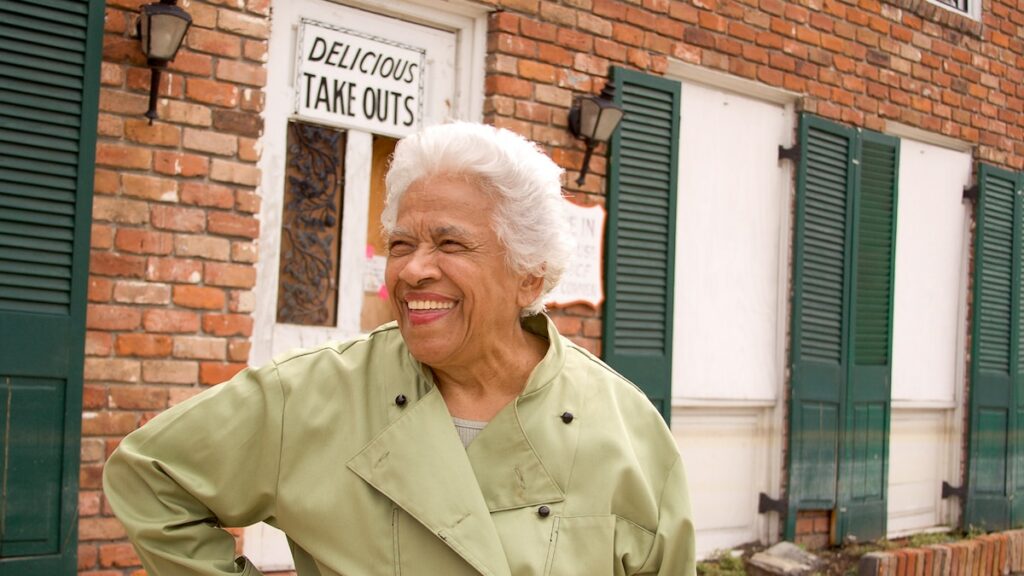Leah Chase, a culinary icon and civil rights pioneer, transformed the gastronomic landscape in New Orleans. Under her leadership, Dooky Chase Restaurant became a sanctuary that shattered segregation barriers, inviting people of color into the realm of fine dining.
As Walt Disney World unveils Tiana’s Bayou Adventure this summer, inspired by Chase’s legacy, here’s a look at the real woman behind Disney’s first Black princess.
Farm-to-table foundation
Born in 1923 in Madisonville, Louisiana, Leah Chase, the eldest of 11 children, was raised with a strong work ethic by her parents, Charles and Hortensia Raymond Lange.
“They came up in a time when people of color didn’t have everything. Her family was poor at the time, struggling to raise their children, but they did it by using the food they grew,” says Stella Chase Reese, daughter of Leah Chase and current owner of Dooky Chase.
Known as the “Queen of Creole Cuisine,” Leah Chase has fed celebrities and politicians such as Quincy Jones, Duke Ellington, Ray Charles, Beyoncé Knowles, and Presidents George W. Bush and Barack Obama as executive chef of Dooky Chase’s Restaurant.
Photograph by Burt Steel, Associated Press
She moved to New Orleans to live with her aunt and continue her education at St. Mary’s Academy. The school’s location in the French Quarter kickstarted Chase’s interest in the culinary world.
“When she was at St. Mary’s, she had an opportunity to peep into a lot of restaurants, and that brought her joy,” Reese says. “That’s when her dream of owning a restaurant really happened.”
Taking on the Big Easy
At 18, Chase started working in French Quarter restaurants, first making $1 a day at the long-since-closed Colonial Restaurant. A newspaper advertisement for an “attractive, light-colored waitress” led her to work at the Coffee Pot on St. Peter Street.
These experiences, combined with her rural upbringing, set her apart from other New Orleans chefs, says Mark Cave, senior historian at the Historic New Orleans Collection. “She had the connection to the earth, to the land, from childhood, and then brought that with her to the big city,” he says.
(Here’s how to indulge your sweet tooth in New Orleans.)
Chase’s work in the French Quarter exposed her to the world of fine dining. For her, dining was not just a meal—it was an experience and the heart of connection.
These connections blossomed as Leah Chase married local musician Edgar “Dooky” Chase, Jr. in 1946. His parents had created a po’ boy shop in 1939 and opened Dooky Chase Restaurant in 1941, overcoming significant hurdles.
Leah Chase and her husband Edgar “Dooky” Chase, Jr. transformed their humble po’ boy shop into a legendary culinary institution.
Photograph by Gift of Harold F. Baquet and Cheron Brylski, The Historic New Orleans Collection
“African Americans had to start businesses little by little because they had no one to loan them money to start any ideas,” says Reese. “My grandmother was able to purchase the building in 1941 that with the help of a vendor willing to put his trust in her.”
Initially, Leah Chase focused on raising her four children. When her youngest child started kindergarten, she joined the family business, bringing her vision to expand it into a sit-down restaurant. “She was just a force of nature who pushed for the best of the best,” Cave says.
Setting the culinary standard
In the early 1960s, in a city deeply divided by segregation, Dooky Chase Restaurant played a crucial role in the Civil Rights Movement, hosting meetings and serving activists like Martin Luther King Jr., Thurgood Marshall, and James Baldwin.
“Unions were big financiers of the Civil Rights Movement, and many who helped organize were white,” Cave says. “[Chase] broke the law serving Black and white people together but got the police to turn a blind eye by feeding them too.”
One of Leah Chase’s iconic pieces of clothing was a red double-breasted chef jacket.
Photograph by Heritage Images, Getty Images
However, Chase questioned if she was making any impact on the movement at all.
“My mother once talked to a priest and wondered what talents she had to create change,” says Reese. “The priest told my mother, ‘How many people could feed the people that you fed and make them happy? You are using the talent that God gave you.’”
(Deconstructing gumbo, Louisiana’s beloved state dish.)
Chase then realized that she had helped fuel the movement. “It was over her food that they strategize their next steps,” Reese says. “She said, ‘I’ve changed the course of America over my bowl of gumbo.”
A lasting legacy
Leah Chase’s influence on Creole cuisine extended far beyond the walls of Dooky Chase Restaurant. The spices and flavors in every dish Chase created earned her the nickname “Queen of Creole Cuisine.” She was instrumental in refining and popularizing Creole cooking, blending traditional recipes with innovative techniques to elevate the cuisine to new heights.
Many prominent chefs, including Emeril Lagasse and John Besh, have cited Chase as a pivotal influence in their careers, instilling in them the importance of using fresh, local ingredients and the significance of culinary heritage.
Chase passed away in 2019, but her legacy lives on through her family and the countless chefs she inspired. Princess Tiana’s story, mirroring Chase’s journey from humble beginnings to culinary excellence, underscores themes of perseverance, hard work, and community support.
>>> Read full article>>>
Copyright for syndicated content belongs to the linked Source : National Geographic – https://www.nationalgeographic.com/history/article/leah-chase-princess-tiana
